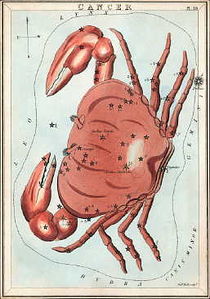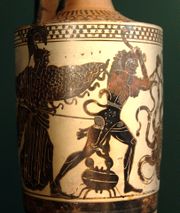Cancer (constellation)
| Constellation | |
List of stars in Cancer |
|
| Abbreviation | Cnc |
|---|---|
| Genitive | Cancri |
| Pronunciation | /ˈkænsər/, genitive /ˈkæŋkraɪ/ |
| Symbolism | the Crab |
| Right ascension | 9 h |
| Declination | +20° |
| Quadrant | NQ2 |
| Area | 506 sq. deg. (31st) |
| Main stars | 5 |
| Bayer/Flamsteed stars |
76 |
| Stars with planets | 2 |
| Stars brighter than 3.00m | 0 |
| Stars within 10.00 pc (32.62 ly) | 2 |
| Brightest star | β Cnc (Altarf) (3.53m) |
| Nearest star | DX Cnc (11.84 ly, 3.63 pc) |
| Messier objects | 2 |
| Meteor showers | Delta Cancrids |
| Bordering constellations |
Lynx Gemini Canis Minor Hydra Leo Leo Minor (corner) |
| Visible at latitudes between +90° and −60°. Best visible at 21:00 (9 p.m.) during the month of March. |
|
Cancer is one of the twelve constellations of the zodiac. Its name is Latin for crab and it is commonly represented as such. Its symbol is ![]() (Unicode ♋). Cancer is small and its stars are faint. It lies between Gemini to the west and Leo to the east, Lynx to the north and Canis Minor and Hydra to the south.
(Unicode ♋). Cancer is small and its stars are faint. It lies between Gemini to the west and Leo to the east, Lynx to the north and Canis Minor and Hydra to the south.
Contents |
Notable features

Planetary system
55 Cancri is a quintuple planet system with four gas giants and one terrestrial planet.
Deep sky objects
Cancer is best noted among stargazers as the home of Praesepe (Messier 44), an open cluster also called the Beehive Cluster or the Gate of Men, which contains the star ε Cancri. The smaller, denser open cluster Messier 67 can also be found here.
Named Stars
| Bayer | Name | Origin | Meaning |
|---|---|---|---|
| α | Acubens | Arabic | the claws |
| β | Al Tarf | Arabic | the end |
| γ | Asellus Borealis | Latin | northern donkey |
| δ | Asellus Australis | Latin | southern donkey |
| ε, M44 | Praesepe (or the beehive cluster) | Latin | manger |
| ζ | Tegmine | Greek | skin |
| λ | Kwan Kei | Chinese | bright fire |
| ξ | Nahn | Persian | nose |
Names
In Ancient Greece, Aratus called the constellation Καρκινος (Karkinos), which was followed by Hipparchus and Ptolemy. The Alfonsine tables called it Carcinus, a Latinized form of the Greek word. Eratosthenes extended this as Καρκινος, Ονοι, και Φατνη: the Crab, Asses, and Crib.
The Indian language Sanskrit shares a common ancestor with Greek, and the Sanskrit name of Cancer is Karka and Karkata. In Telugu it is "Karkatakam", in Kannada "Karkataka" or "Kataka", in Tamil Karkatan, and in Sinhalese Kagthaca. The later Hindus knew it as Kulira, from the Greek Κολουρος (Koloyros), the term originated by Proclus.
In Ancient Rome, Manilius and Ovid called the constellation Litoreus (shore-inhabiting). Astacus and Cammarus appear in various classic writers, while it is called Nepa in Cicero's De Finibus and the works of Columella, Plautus, and Varro; all of these words signify crab, lobster, or scorpion.
Athanasius Kircher said that in Coptic Egypt it was Κλαρια, the Bestia seu Statio Typhonis (the Power of Darkness). Jérôme Lalande identified this with Anubis , one of the Egyptian divinities commonly associated with Sirius.
Representations

The modern symbol for Cancer represents the pincers of a crab, but Cancer has been represented with various types of creatures, usually those living in the water, and always those with an exoskeleton, decapods in particular.
In the Egyptian records of about 2000 BC it was described as Scarabaeus (Scarab), the sacred emblem of immortality, although Peter Jensen claimed this sign had been a tortoise in Babylonia, and that it was so figured there and in Egypt 4000 BC. In the 12th century, an illustrated astronomical manuscript shows it as a water beetle. Albumasar writes of this sign in the work published in 1489 as a large crayfish. Jakob Bartsch and Stanislaus Lubienitzki, in the 17th century, described it as a lobster.
Mythology

Cancer the giant crab, plays a minor role in the Twelve Labors of Hercules. While Hercules was busy fighting the multi-headed monster, Lernaean Hydra, the goddess Hera, who hated her step-son Hercules, sent the Crab to distract him. Cancer tried to kill Hercules, but Hercules kicked Cancer so hard that the crab was sent into the sky.
By other accounts, Cancer grabbed onto the hero's toe with its claws, but barely breaking the rhythm of his great battle with Hydra, Hercules crushed the crab with his foot. Hera, grateful for the little crustacean's heroic but pitiful effort, gave it a place in the sky; but none of its stars were bright because the crab had failed to accomplish its given task.[1] Some scholars have suggested that Cancer was a late add-on to the myth of Hercules to make the Twelve Labors correspond to the twelve signs of the Zodiac.[2]
Cancer is said to have been the place for the Akkadian Sun of the South, perhaps from its position at the summer solstice in very remote antiquity. But afterwards it was associated with the fourth month Duzu (June-July in the modern western calendar), and was known as the Northern Gate of Sun.
Showing but few stars, and its brightest stars being of only 4th magnitude, Cancer was often considered the "Dark Sign", quaintly described as black and without eyes. Dante, alluding to this faintness and position of heavens, wrote in Paradiso:
| “ |
Then a light among them brightened, |
” |
Astrology
As of 2002[update], the Sun appears in the constellation Cancer from July 21 to August 9. In tropical astrology, the Sun is considered to be in the sign Cancer from June 21 to July 22, and in sidereal astrology, from July 16 to August 15.
References
- Star Names: Their Lore and Meaning, by Richard Hinckley Allen, Dover. ISBN 0-486-21079-0
- Ian Ridpath and Wil Tirion (2007). Stars and Planets Guide, Collins, London. ISBN 978-0007251209. Princeton University Press, Princeton. ISBN 978-0691135564.
- Dictionary of Symbols, by Carl G. Liungman, W. W. Norton & Company. ISBN 0-393-31236-4
External links
|
||||||||||||||
|
|||||
|
||||||||||||||||||||||||||||||||
| Astronomy | Constellations of the Zodiac |
|---|
| Pisces ★ Aries ★ Taurus ★ Gemini ★ Cancer ★ Leo ★ Virgo ★ Libra ★ Scorpius ★ Ophiuchus ★ Sagittarius ★ Capricornus ★ Aquarius |